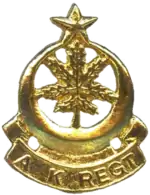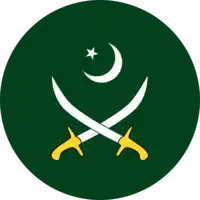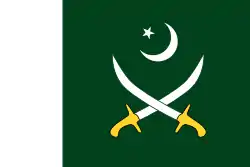Azad Kashmir Regiment
The Azad Kashmir Regiment, also known as AK Regt, is one of the six Infantry Regiments of the Pakistan Army. As per the order of seniority, it is the Fourth regiment, but first to be raised after the Independence of country from the British Colonial rule of India. Its Regimental Centre is located at Mansar camp in Attock District on the border of Punjab and KPK province. The Regiment has participated in all major and minor operations and wars fought by the army and displayed high standards of valour.[2][3][4] Notable commanders of the regiment include including Lieutenant-General Haroon Aslam, ex commander of Pakistan Special Services Group who led the SSG operation (Operation Rah e Rast) in Swat in 2009 and Lieutenant General Hidayat ur Rehman, who commanded successful operations (Operation al-Mizan and operation Zarb e Azab) in FATA from 2014 to 2016.[5][6][7]
| Azad Kashmir Regiment | |
|---|---|
 Regimental cap badge | |
| Active | 1974-Present |
| Country | |
| Branch | |
| Type | Infantry regiment |
| Role | Standard Infantry with 10 Heavy Anti Tank, 1 Light Commando |
| Size | 29 Battalions in 8 brigades (51 to 59)[1] |
| Regimental Center | Mansar |
| Patron | Khan Liaquat Ali Khan, 1st Prime Minister of Pakistan |
| Facing Colours | Green & Red |
| Mascot(s) | Maple Leaf |
| Anniversaries | Defence Day |
| Equipment | APC M113A, TOW, TOW-II, Milan, BSWS |
| Engagements | Indo-Pakistani War of 1947 Indo-Pak War 1965 Indo-Pak War 1971 Siachen conflict Indo-Pak War 1999 War in Afghanistan War in North-West Pakistan Unified Task Force United Nation Military missions Balochistan Conflict |
| Battle honours | Jammu 1948 - Kashmir 1948 - 1965 Indo Pak War - Operation Gibraltar - Operation Grand Slam - 1971 Indo Pak War - Operation Koh Paima - 1999 Kargil War |
| Commanders | |
| Colonel Commandant | Lieutenant General Sher Afgun |
| Notable commanders | 1- General Abdul Whaeed Kakar, COAS Pak Army
2- Lieutenant General Haroon Aslam, ex Commander SSG 3- Lieutenant General Ishfaq Nadeem Ahmad, ex Commander 2 Corps 4- Lieutenant General Ikram ul Haq, Commander XXX Corps 5- Lieutenant General Hidayat ur Rehman, Commander XI Corps 6- Lieutenant General Javed Hassan, HI (M) 7- Lieutenant General FS Lodhi, HI (M), S Bt 8- Lieutenant General Ishfaq Nadeem, HI (M) 9- Lieutenant General Zia Ullah Khan, HI (M) |
| Insignia | |
| Identification symbol | The Chinar Leaf and Crescent |
Historical background
The Azad Kashmir Regular Forces, established in 1947,[8] were armed and supported by the Pakistani government. The regiment has the distinction of not having been raised by any government order, but "raised itself" when bands of armed World War II veterans[9] organized themselves into disciplined ad hoc platoons, companies and battalions led by retired officers, JCOs and NCOs, and went out to fight in Kashmir against the Indian Army in 1948.[10] The new AKRF was mostly consisted of 60,000 ex servicemen of British Indian Army, majority Second World War veterans with many Muslims.[11] At the end of war these veterans, still young and fit, opted out of forces. The Indo-Pakistani War of 1947 continued for 15 months from Oct 1947 to 31 Dec 1948. After a cease-fire was declared in Kashmir, these elements joined together to form the Azad Kashmir Regular Forces (AKRF). The AKRF had its own intake and training structure separate from the Pakistan Army. The AKRF was the military element of the Azad Kashmir Government. Uniforms and rank structures were the same as in the Pakistan Army. At that time, all the battalions of the AKRF were part of the 12th Infantry Division of the Pakistan Army, permanently stationed in Azad Kashmir.
Originally created as militia and later a paramilitary force of Pakistan, the Azad Kashmir was amalgamated into the Pakistan Army in 1974 as an infantry regiment.[12]
Commandants of the Regiment
Notable Colonel Commandants of the regiment have included Maj Mehtab Khan (Baloch Regt) (Defence Sectary Azad Kashmir) Lieutenant General Zia Ullah Khan HI (M) (3 NOV 1993 to 2 NOV 1997),[13] Major General Sardar Muhammad Anwar Khan, the former President of Azad Kashmir, Lieutenant General Javed Hassan, who as a Major General commanded the Force Command Northern Areas (FCNA) during the 1999 Kargil War and later served as the commander XXX Corps, Gujranwala.[14] Major General Mukhtar Ahmed,[15] Lieutenant General Haroon Aslam and Lieutenant General Ishfaq Nadeem Ahmad. General Abdul Waheed kakar, ex COAS Pak Army has remained the Colonel In Chief of the Regiment. At present the regiment is headed by Lieutenant-General Ishfaq Nadeem Ahmad. Other notable commanders of present era include Lieutenant-General Ikram ul Haq—commander XXX Corps, Lieutenant General Hidayat ur Rehman—commander XI Corps and lieutenant General Sher Afgan, XXXI Corps.
War history
Kashmir 1947–48
What began as a revolt by young rebels and ex servicemen turned out to be a big setback for tripartite alliance of Maharaja of Jammu and Kashmir, Indian Government and remnants of outgoing British colonial authorities still in control of India and partial control of Pakistan. To quote the words of Pakistan Army's Official Portal "They liberated over 34,000 square miles of the State's territory that is now called Azad Jammu and Kashmir and Northern Areas." AKRF began its struggle as Armed Militia known as Lashkar, Ghazis and Jathas. As the volunteers swelled the ranks and files, a command structure was established to control these para military force of vigilante. Being well aware of aspirations of the people of State, Pakistani Government under the leadership of Governor General M A Jinnah and Prime Minister Liaquat Ali Khan decided to support the Lashkars. British C in C of its Army, General Frank Messervy refused to obey the instructions of M A Jinnah. However, AKRF took Muzaffarabad by 13 October 1947, Mirpur by 25 November 1947 and Jhangar in December 1947. India meanwhile managed to get the Instrument of accession signed by the Hindu Maharaja of state and landed its Military forces in the valley using massive air lifts. Fierce fighting continued for over a year but AKRF with the assistance of Pakistani tribals and regular army managed to capture Districts of Mirpur, Bhimber, Kotli, Bagh, Rawlakot, Muzaffarabad and Neelum. A total of 2633 all ranks of the regiment died during the war.[16] Naik Saif Ali Janjua[17] of 5th & 18th Battalion of AK Regt (Haider Dil) & (Al Saif) was awarded Hilal-e-Kashmir at Mendhar sector of Jammu. He was commanding a platoon at Pir Kalewa feature and died on 25 Oct 1948 during the battle of Pir Kalewa which was attacked by 5 Infantry Brigade of Indian Army.
Indo-Pak War 1965
In wartime operations, the AKRF was part of the Order of Battle of the Pakistan Army, in which it was involved in 1965 Operation Gibraltar. All of the AKRF battalions were part of the 12th Infantry Division (Pakistan) that carried out Operation Gibraltar as well as defended Azad Kashmir. Subedar (later Honorary Captain) Muhammad Israel Khan of 39th AK Regt was then part of Ghazi Battalion. He was awarded second Sitara E Jurat for his bravery. He had previously won an SJ in 1948 during the Battle of Paran Hill[18] at the foothills of Pir Badesar in 1948. During the same operation one of the Company Commanders of 21 Azad Kashmir Regiment, Major Malik Munawar Khan Awan, became famous for his heroic action and occupation of Indian Garrison of Rajauri while commanding Ghaznavi Force during Operation Gibraltar. Later Major Munawar was awarded "Sitara e Jurat" for gallantry and the title of "King of Rajouri" by President Field Marshal Muhammad Ayub Khan.
Indo-Pak War 1971 and subsequent operations in Kashmir
The Azad Kashmir Regular Forces fought in the 1971 war and then in 1972 when the 9th Azad Kashmir Battalion defended Chakpatra and Leepa Valley against a larger Indian force composed of several regular battalions. This particular battalion was first led in 1948 by Lt Colonel Ghulam Rasul Raja-Sitara-e-Jurrat (1948), Military Cross (WWII). During the Battle of Leepa Valley the 9th AK Battalion with 25 Mountain Regiment Artillery distinguished itself under the leadership of Lt Colonel Haq Nawaz Kyani, SJ and Bar,[19] who died leading the battalion from the front. The Company Commander of B Coy called for artillery fire upon their own position while being over run by the enemy; in doing this they repulsed the enemy attack. The Pakistan Army later honoured the AKRF by absorbing it into its own ranks and by giving it the status of a Regular Line Infantry Regiment. The AKRF thus became the Azad Kashmir Regiment on 20 September 1972.
Operations along LOC
The regiment has involved in all Indo-Pakistani War and has always deployed on the LOC. Notable operations by the Regiment in LOC environment include Battle of Pir Kalewa,[20] Battle of Paran Hills, Siege of Poonch, Battle of Mirpur, Battle of Kotli, Battle of Muzaffarabad, Operation Grand Slam, Operation Gibraltar, Leepa Action, Chumik operation, Siachen operations, Operation Koh Paima and countless other major and minor operations. In recognition of bold and brilliant performance of Regiment, it was changed from an irregular to regular Infantry regiment on 20 September 1971.[21]
Operations Along Western Front
Regiment has distinguished itself during the operation Rah e Rast and Rah e Nijat in Swat valley. The Swat operation was led by (then) Major General Muhammad Haroon Aslam, the commander of the (36th Azad Kashmir Regiment) Azad Kashmir Regiment.
International assignments
Regiment's experience transcends the borders of motherland. Its battalions have served on at least four continents as part of international peace keepers under the UN mandate[22] or training battalions for friendly countries. The International duties include Bosnia, Haiti, DRC (Congo), Liberia, Côte d'Ivoire, Brundi, Sudan and Bahrain. The experience of its all ranks employed on independent duties surpasses the list and includes all continents of world.
Casualties and gallantry awards
According to sources, the regiment has lost 3000 soldiers, of which 2633 were in the 1947-48 Kashmir War alone.[23] In recognition of this service, the Azad Kashmir Regiment have been bestowed with a full range of National and International gallantry awards. The Regiment's gallantry awards includes a "Nishan E Haider" awarded to Naik Saif Ali Janjua of 5th/18th Azad Kashmir Regiment in 1948.[24] This award is equivalent of Britain's Victoria cross and United States Medal of Honour. List of gallantry awards is covered in first edition of Regiment's History published by the Regimental Center in the 1990s and second edition currently under production.[25]
Peacetime performance
When not engaged in operations of war, the Regiment continues to train. Its battalions have a habit of displaying highest standards of training, sportsmanship and military professionalism. 8th Battalion of the Azad Kashmir Regiment won Gold Medals and secured 1st position in Exercise Cambrian Patrol, considered to be the toughest military training competition of the world.[26] Regiment has a Bagpipe band, considered to be the best of Pakistan Army. The band has represented Pak Army internationally, a number of times[27][28]
References
- https://web.archive.org/web/20160322050842/http://www.globalsecurity.org/military/world/pakistan/rgt-ak.htm
- "Naik Saif Ali Janjua". www.pakistanarmy.gov.pk. Archived from the original on 2016-11-28. Retrieved 2016-11-27.
- "The Forgotten One, Naik Saif Ali Janjua (Shaheed)". Pakistan Defence. Retrieved 2016-11-27.
- ""Remembering Lt Col Haq Nawaz Kayani (Shaheed), SJ & Bar"". Native Pakistan. 2014-11-18. Retrieved 2016-11-27.
- "Major General Hidayatur Rehman of Gilgit Baltistan promoted Lieutenant General - Sost Today". Sost Today. 2014-09-22. Retrieved 2016-11-27.
- "Lt Gen Hidayat Ur Rehman, first Corps Commaner [sic] From GB". Pakistan Defence. Retrieved 2016-11-27.
- "COLONEL COMMANDANTS- AZAD KASHMIR REGIMENT". www.pakarmymuseum.com. Retrieved 2016-11-27.
- https://www.scribd.com/document/324043639/Indias-Wars Page 150, Part III of "India's Wars A Military History 1947–1971" by Air Vice Marshal Arjun Subramniam - Published by Harper Collins India
- http://www.defencejournal.com/2000/apr/war-lost.htm Research Article War of Lost Opportunities by Agha Humayun Amin Paragraph 3, Lines 23–24
- https://www.academia.edu/2473712/THE_FIRST_INDO-PAKISTANI_WAR_1947-48 Research Article by Peter Almo Kis, Page 12, Paragraph under the heading "December 1947 to April 1948 – winter and spring offensives"
- ^ http://www.defencejournal.com/2000/apr/war-lost.htm Research Article War of Lost Opportunities by Agha Humayun Amin Paragraph 3, Line 23 - 24
- https://web.archive.org/web/20160322050842/http://www.globalsecurity.org/military/world/pakistan/rgt-ak.htm
- http://www.pakarmymuseum.com/exhibits/colonel-commandants-azad-kashmir-regiment/
- Yaqoob Malik. "Armed forces proved their capability: Musharraf" Dawn, April 5, 2003
- "Maj Gen Mukhtar New Colonel Commandant AK Regiment" paktribune.com, 28 September 2007
- History Of The AZAD KASHMIR REGIMENT Volume I, Page 436
- http://blogs.dunyanews.tv/14410/11th-nishan-e-haider-pakistan-naik-saif-ali-janjua
- Page 85, the History Of The AZAD KASHMIR REGIMENT Volume I
- ""Remembering Lt Col Haq Nawaz Kayani (Shaheed), SJ & Bar"". Native Pakistan. 2014-11-18. Retrieved 2016-11-27.
- http://defence.pk/threads/the-forgotten-one-naik-saif-ali-janjua-shaheed.34302/
- "Archived copy". Archived from the original on 2016-11-28. Retrieved 2016-11-27.CS1 maint: archived copy as title (link)
- http://www.dawn.com/news/1215166
- History Of The AZAD KASHMIR REGIMENT Volume I, Page 436
- http://www.pakarmymuseum.com/exhibits/naik-saif-ali-janjua-shaheed/
- http://pakdef.org/operational-military-awards-for-kargil-war-heros/
- http://tribune.com.pk/story/979201/pakistan-army-wins-gold-in-exercise-cambrian-patrol-in-uk/
- https://www.youtube.com/watch?v=nOiOG227il4
- http://www.pakarmymuseum.com/exhibits/history-of-army-school-of-music/

